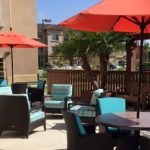-
THANK YOU!
So very, very much!
Last week at this time we were at a total loss as to what to do, where to go, who to turn to for the care my dad suddenly needed. That all changed with one phone call (to Michael)…and one email (from Sayra)… It’s been a whirlwind since then, as you know, but in a good way, the best way possible, for my dad and this new chapter of his life... From the minute we walked in, he (and we!) felt welcomed and "at home"... There are challenges and adjustments of course, but mostly there is a sense of peace and gratitude that if he can't be home...he can still feel like he is.
So...
thankyouthankyouthankyou
again!
We are and forever will be, grateful for that one phone call and that one email that made all the difference. What you do is appreciated, in ways you could never know!!!
Take care!
Best to you both!
Keep doing what you do!!!
LANDI FOR HER FATHER LARRY
Carmel Valley
-
Mike, you and your team have been great. Sayra has been heartfelt in her approach - it truly does take a village. Many thanks to all of you!
MALERIE FOR HER FATHER DENIS
-
I LOVE Care Placement. During a very difficult time with our parent, every challenge imaginable seemed to appear out of nowhere. Mike Ortman was recommended, and in his calm, compassionate manner, he found solutions faster than more challenges could find us!! The perfect home appeared, complete with ready made friends, activities and care. Our parent (after an adjustment time) became social, active and involved with friends for the 1st time ever and now looks forward to "getting back home."
Forever grateful to Mike Ortman at Care Placement
-
My deepest thanks to you for your help in finding a new home for Frank. He has settled in, and I am always impressed when I visit. Sandy and the staff at Secure Seniors are very warm and caring. I believe he is in a good place. Ken, your knowledge and expertise in this area is a total godsend to people like me who suddenly face these daunting decisions. I will never forget your kindness. And I have had some lovely chats with Lois when she calls to check up on the situation! You are special people involved in important, supportive work for families. I feel fortunate to have "met" you all.
SUSAN FOR HER HUSBAND FRANK
Escondido
-
I just wanted to say a long-overdue thank you to Michael and your service. It was definitely a blessing for me. I was overwhelmed when needing to choose care for my parents in a dire situation. Michael made that process so easy. The resources he offered were so valued. I got my parents into Pacifica Assisted Living. I was able to get a Trust and Will set up, and Veteran Benefits as well. My mom passed away in January of this year. My dad is still living at Pacifica. I still have their home in the Trust and at some point it will be the last issue to deal with. Thank you for checking in. It is much appreciated.
CARRIE FOR HER PARENTS
-
Dear Michael and Sayra:
My brother and I wanted to thank you for all your efforts in helping us find a facility to place mom in during her last days… This could not have turned out any better. She received fantastic care and more importantly, it relieved us of the burden of her day to day care. This allowed us to enjoy visiting with her during the last days of a long and accomplished life…
This was a long winded way of telling you how much we appreciated your help in this difficult journey. We could not have done it without you. The two of you are really exceptional at what you do and we will not hesitate to recommend you in the future to our friends who find themselves in similar circumstances.
MARK FOR HIS MOTHER
-
I thank God for putting Chris is our lives, when Mom needed help the very most. Everyone was telling me when Mom was in poor condition in ICU how amazing Chris was. Chris from the bottom of my heart, thank you so very much for all that you have done for Mom. You are such a blessings to us and to others, and for that I thank you.
TERRI FOR HER MOTHER
Orange
-
Your company is a gem. I am also a paralegal, and am used to research, but you cut down on that task considerably by sending us information on places that you recommend. Mom had no idea where to start when she started looking last June, (nor would I), and then she sent me the email with the recommendations from you. I now had the field narrowed for me, and that made an easier trek of it.
TINA
Mira Mesa
-
Your office has been so supportive, understanding and helpful. You have relieved much of the stress I feel in trying to deal with these issues.
DEAN
Orange County
-
I've recommended your services to several people. I've found many people are curious about where my uncle is and how I found the place. They are in the position of placing a loved one into a facility in the near future. I appreciate your services and your follow up. Allen was great to work with and very helpful for guiding me to options and answering my questions. Kudos. Thank you, Terralyn H
TERRALYN FOR HER UNCLE
Mission Beach
-
Your service took much of the legwork out of a task I found quite daunting... emotionally and physically. Ian Wiese was always there when needed, checking in and giving encouragement at just the right time. I will HIGHLY recommend Care Placement!
TAMARA FOR HER MOM RAMONA
Bonita
-
I want to thank you Doug, and your staff, for being so helpful and responsive. I don't believe we would have found such an appropriate placement for my mother so quickly, without your very timely assistance! We are truly grateful.
KETHRYN
Brea
-
I am so grateful to Care Placement! You made a very difficult situation so easy for me, and more importantly, my mother.
PAULETTE FOR CARMEN
San Diego
-
Thank you for helpimg us find a beautiful residence for my mother. The administrator is wonderful and the caregivers are so kind and patient. Michael Ortman and his assistant Sarah Winfield were so helpful without the pressure I have experienced with some other agencies. Thank you again for your help.
ANN FOR HER MOTHER NETA
Oceanside
-
I LOVED Ian! He is so sweet and caring, I am already telling everyone to call him if they ever need placement help. He's the best!
SHERRY FOR HER MOM ELAINE
East County
-
Thank you for following up on Larry Martinez. He really likes the facility and feels very comfortable there. He likes having his own space to call home. Everyone is nice and friendly. He likes the meals and the amenities they have to offer. I would definitely recommend it. Mike Harrity was great to work with and I am so happy he had it on his list for us to consider.
JEANNIE FOR HER BROTHER
Orange County
-
They took excellent care of my mom. Everyone there was so nice, and showed they truly cared. I highly recommend them.
LORI
Poway
-
Dear Sarah and Michael: I can't thank you enough for your help in finding a place for mom. I do have a friend with a friend who may need your services. I will give her your contact info when I see her next. Thanks again - a satisfied customer, Susan
SUSAN FOR HER MOM
Chula Vista
-
I was extremely happy with Ian's following up during this process. He is wonderful. I absolutely would recommend your placement service to anyone. Again, thank you, and especially Ian.
JOANNE FOR VIVIAN
San Diego County
-
Ken recommended some wonderful facilities and a fantastic Caregiver Agency. Thank you again for all of your help. It made getting help for my mother-in-law so easy. Thank you again for your heartfelt sympathy. It is so appreciated at a time like this.
CLAUDIA
North Inland
-
We were very thankful to find out about Care Placement and the service you provide. Our mother is very well treated at her care home. When possible, we have given your business name to others looking for help for their family members.
C.V. FOR BLANCHE
Orange County
-
Care Placement had been such a consolation for me. Ken knew exactly what we needed for my mom. [...] Please thank Ken for his patience and good counsel with my family. You guys were great and I still recommend you to my friends and family.
JULIE FOR HER MOM, DORRIS
Poway
-
Thank you for providing such an important service.
PAT
San Diego
-
Allen, Thank you once again for your time and efforts on our behalf. It is a relief to know your caring services exist.
NANCY FOR HER FATHER, SAM
College Area
-
I just wanted to say thank you very much for everything. I do remember talking to you over the phone but I was a bit lost in the events that have unfolded. One thing is clear now and that is Ian has been a great help and without his services Mom would have been seriously neglected by the system. I can't thank you all enough...
BRAD FOR HIS MOM
East County
-
Mom absolutey LOVES her 'new home'. The kind and loving care of the staff, the EXCELLENT food, the spotless cleanliness, the level of organization, attention to detail (ESPECIALLY with Mom's many medications) is worthy of the highest praise and recognition. It all happened so suddenly for all of us, and there is not a one of us in our family who is not overjoyed to have discovered, through Mike of course, the most wonderful care home(s). I already referred some friends to Care Placement. All the best to Abby and Mike too in their worthy endeavors creating happiness for families such as ours.
GLENDA FOR HER MOM, PHYLLIS
Mission Viejo
-
Both places would have been great for my dad. Thanks again for the referrals......you made my research in finding a nice home for my dad so easy and stress free during such a difficult time.
MARJORIE
San Diego County
-
Thanks again for your assistance at a difficult time in the life of my family that was made much easier by you folks.
JUDY
Alpine
-
I'm so thankful for Ken's help and recommendations. I have give his card to several friends who are anticipating the future for their parent and will need his assistance. Everything he said was factual and he prepared me for the process. Thank you so much.
PATTI FOR HER MOM, MAE
North Inland
-
Mike was a god send to me. He's the first person I'd turn to at the next placement issue.
NANCY FOR HER MOM BEKKE
San Juan Capistrano
-
Mike, thanks for your kind phone message today. You're amazing.
TOM
San Diego County
-
Thank you Michael for all your help, patience, and kindness. You made making an extremely difficult decision less stressful. We are very satisfied with the services of Care Placement.
PENELOPE FOR HER FATHER WILLIAM
El Cajon
-
I really appreciate the help from Allen, I wouldn't know where to look if it weren't for his help.
CATHY FOR HER MOM LOUISE
La Mesa
-
I am really appreciative of your service. We needed to get my dad into a place quickly and doing a lot of research would have taken a lot of time. I will definitely recommend your service.
TOM
San Diego County
-
The referral for George seems to be ideal for him in every respect. I appreciate John's assistance and referral. Thank you.
SANDRA
Clairemont
-
Michael has been incredibly helpful. Our mom continues to get stronger so there is no immediate need for another facility. In the future, when we do go visiting, we have promised to mention Care Placement and Michael Ortman.
TOM FOR SHIRLEY
Carmel Valley
-
I want to thank you so much for your recommendations, Ken. You had been helpful with the placement of my husband, and now you helped us finding the wonderful residential care home for my brother-in-law.
SUE
-
Hi Michael -- Just wanted to get back with you and thank you so much for all your help in referring me to various facilities in full board and care for my dad. The good news is we have chosen to go with Michele of Lafayette Home Care. Our plan is to move dad in on Friday, July 4th. Still working to get him out of his current location though. Additionally both sites you referred to me in my area were wonderful from facilities to administrators. And I can honestly say both places would have been great for my dad. Thanks again for the referrals......you made my research in finding a nice home for my dad so easy and stress free during such a difficult time. My Best, Marjorie
MARJORIE FOR LARRY
South Bay
-
Please tell Allen thank you for his help in finding Erachel. He was a godsend. I only had a few days to find a place and it's perfect. Thank you!
CARRIE FOR HER MOM
South Bay
-
Please pass along my thanks to Allen for his time and "perfect" placement abilities. I carry his card in my wallet in case I can ever pass it on. I can finally sleep well knowing my mom is safe and well taken care of, in a clean, caring home. She feels comfortable and gets good care. All the caregivers are extremely caring and attentive. The owner and his wife are always available and want all the residents to feel like family. Safety is a priority there. I would highly recommend placement here to anyone should any rooms become available.
TINA FOR HER GLORIA
El Cajon
-
I'm so pleased with your referral. Ken did me a service that is out of this world. Thanks a million.
HARRY FOR HIS WIFE MARION
Orange County
-
I would like to express how pleased I was with your service and especially Ian. He went above and beyond the call of duty. He was even going to go talk to my Dad to help him settle into his new place. A very nice and unselfish gesture. Thanks to you and your staff.
LYNN FOR PARENTS HELEN & BOB
-
As a Social Services worker I have personally worked with patients who have used Care Placement's services and have found them to be professional, timely, and sensitive to the family's specific needs. I would certainly recommend Care Placement.
PHILLIP
Riverside
-
Thanks to you Mike, and your staff, for the immediate assistance you provided, sending us a list of potential Board & Care places within hours of us speaking with you and for checking in with us periodically to make sure we had what we needed to find a good home for our mom. Now that is service!
GEORGE & CHRISTINA FOR GLENNA
Orange County
-
At the time, I thought it would be an easy task to find a facility for my mother. I was resistant to utilizing a placement specialist and thought I could handle it myself. It was an overwhelming experience! The day I met Michael, he immediately went to work. With the information I provided. He and his assistant Sarah found several places that fit my criteria. They emailed a profile of the different places and then did a follow-up to find out if I had been contacted by the facilities. I finally found a nice facility, close to me. Sarah sent an email asking about my experience so far with the one I had chosen. Their professionalism and genuine care made a huge difference and I would not hesitate to recommend Care Placement to anyone who is undergoing the same experience.
SHERRY FOR HER MOM, BARBARA
East County
-
Thanks Ken for helping us find such a wonderful care home for my mom. We are so happy with the quality of the home and their care and couldn't be more pleased with your services.
SONYA FOR ETHEL
Lakeside
-
I know we made the right choice for her and you and Ken were most helpful in every way. My sincere thanks for all of your help at this difficult time.
TERRI FOR HER MOM
North Inland
-
Allen, you were so kind to listen to our story and our challenges. I wish to thank you for the referral. You listened and you so graciously said that perhaps you had one more person who may be able to assist in finding mother a home that she deserves. Our family thanks you for your understanding and compassion.
YOE FOR HER MOM, FRANCES
South Bay
-
Jack is being very well cared for. I visit him everyday. Whoever helped me that day were two guardian angels, heaven sent! I am very happy.
EDNA
San Marcos
-
My mom is in her last days the Hospice nurse told me yesterday. Thank you to you and Allen for the help and support you gave me in finding a nice, clean place for her. The staff is so nice, and caring. I thank God for sending you my way.
MARTI
La Mesa
-
We were very impressed and appreciative of Ken Mortensen. He called us back within 30 minutes of mom being in the Emergency Room. The Doctor told us she couldn't return home, so Ken sent us 2 care homes almost immediately. We chose one of them and moved mom in. Unfortunately, she passed away a few months later.
MARTIN & BARBARA
-
Everything went very smoothly. The staff is wonderful and Mom is really making good progress. You will never know how appreciative I am for your help and direction. I would probably still be looking and touring facilities if it wasn't for you. Thank you again, Kim
KIM
La Mesa
-
Thank you for your excellent service, Rachelle. You are on the ball and up to the MINUTE, helping us with our needs before we even ask you.
SUE FOR HER FATHER WILLIAM
Lakeside
-
Thank you Mike for all of the leads your agency provided. Your agency was a godsend and I appreciate the kindness, care, and concern that was extended to me, along with the thorough info you provided. I will absolutely refer others to you when those close by are faced with these types of decisions.
SYBIL FOR MOM AUDREY
Downtown San Diego
-
Michael Ortman found a wonderful home for my ailing brother in San Diego, since I was too ill to be there. He took care of a thousand problems... he even introduced me to other experts and advised me on difficult issues. He went out of his way to check everything out and kept in constant contact by telephone. I highly recommend Michael at Care Placement to anyone whose loved one needs immediate care. He will take a world of worry off your shoulders.
CYNTHIA FROM MARYLAND
Spring Valley
-
Everything is going fantastic! I don't think we would have found a better place than Mike Harrity's recommendation- they are wonderful people and my dad's improved health is definite proof of that! My sister and I couldn't be happier! We are so grateful to Mike!
SANDY
Mission Viejo
-
Thanks to Care Placement for recommending an awesome home for my mother.
J S.
Vista
-
Thanks so much. I really appreciate the help you all have given. Being across the country and not knowing anything about the facilities makes it hard but Allen's recommendation was perfect.
PARIS FOR HIS MOTHER, ANGELA
San Diego
-
When anyone asks about long term care, elder care, or assisted living, I tell them one name, Care Placement, and I have their phone number in my cell.
CYRIL FOR HIS BROTHER STEPHEN
San Diego
-
We appreciate Allen's recommendation. I am convinced this is the right place for my dad. I hope that he can stay there for a very long time.
E. B.
Lemon Grove
-
My sister and I can't say enough good things about Mike Harrity and the way he "held our hands" and counselled us when we were looking for the right placement for our dad. Mike's advice about not waiting for a catastrophic event really gave us comfort when my dad was not being realistic about his need for care.
KATHLEEN FOR HER FATHER, CHARLES
San Clemente
-
Thank you so very much for your assistance in helping me find a good place for my Aunt Patricia. I worked for nine years in a member service position for Kaiser Permanente. Mike helped me organize the pertinent information and got me headed in the right direction right away. Thank you Mike.
DEAN
Orange County
-
Your service was outstanding Michael. You narrowed down all the criteria to help us find the right home in the right location, all laid out very systematically, your descriptions, pictures, etc. Vista was the first we toured, it's the ideal place for her. No complaints, nothing but praise for the place, the price, and the owner's communication with me. I couldn't have asked for more.
PHIL FOR MOM MARIE
San Diego County
-
Thank you Doug and Holly, for all of your help in assisting my family to find suitable placement for my Dad. What you do is so very important. I wish you the very best as you continue to provide care options to families in need of your expertise.
TERI
Orange County
-
Dear Abby, [...] Thanks to you and Mike for your time and for identifying some great places for me to check out back in early Feb. It really made my job much easier. [...] Thanks again for the due diligence you all do up front that made it so much easier for us to find a great place for mom.
MICHAEL FOR HIS MOM
Huntington Beach
-
My mother moved to a lovely home in Solana Beach. We couldn't be happier. Thanks for your leg work in finding the perfect home.
DORA
Solana Beach
-
Thanks Ken for finding me a fantastic place with wonderful care. It is beyond my expectations.
LOUIS
Carlsbad
-
A big thank you your agency for helping me find a 5 star facility for my sister. Thanks for all your help.
JENNIFER
Orange
-
Thank you for asking. Well...You just do not know how grateful I am that Mike send us several places so that we knew the minute we walked in to her current facility, IT WAS THE PLACE FOR MY DAUGHTER! And she has been there about a month and my feelings are the same. I will always thank Mike and I will tell anyone who needs a place to contact him.
CELESTE FOR HER DAUGHTER CHAYLENE
South Bay
-
Doug & Abby - Thank you for helping find a great place. Appreciate your being there when needed to find a place and checking in after move in to make sure he was okay. You both are very professional and I will refer other people to you too.
CAROL
Santa Ana
-
I really appreciate Ken and his help through everything. I gave his name to several people I know. He's on top of things and steers you in the right direction.
JANET FOR HER PARENTS, MR. & MRS. LEWIS
Rancho Bernardo
-
Thank you Ken for your prompt and efficient service. I received a list of options right away and by the next day we found a great care home for my bedridden mother. I am so grateful for your help. You saved me so much time.
BETH FOR ESTHER
Escondido
-
Thank you Ken for helping us find Redwood Terrace. I have told all of my friends to contact you for assistance. You did an amazing job of finding the right place for my wife and I.
JACK
Escondido
-
Mom is settling in very well. I am very pleased with the house, location and staff. I am confident that Mom is safe and well cared for. The administrator is a professional as well as a kind, sympathetic lady. I appreciate everything you and Allen have done to help me find Mom a place she can rehab and thrive in. It is a great relief knowing she is in a good, nurturing environment. Thanks for all you do and checking in on us.
DEBBIE FOR HER MOTHER VAL
Santee
-
Ken and Holly were absolutely the best! The facility you recommended is extremely caring, clean, responsive, and friendly. They truly care about their residents.
CHRISTINE FOR CATHERINE
Escondido
-
I can finally sleep now at night. You were extremely helpful in finding a facility for my mom. Thank you again!
LINDA
San Diego
-
I can't tell you how happy I am with your referral. It's a match made in heaven. Thank you from the bottom of my heart.
WIFE OF ANTHONY
San Diego
-
Thank you and Cody for placing my father in a wonderful environment.
CINDY
Clairemont
-
First of all, we can't thank Mike enough for all of his TLC at one of our most stressful times. His calm demeanor and encouraging remarks led us to a perfect place for our Mom. [...] We're very thankful for crossing paths with Care Placement and especially meeting Mike. he puts his heart into his job and it shows.
JOYCE FOR HER MOM, CLARIBEL
South Bay
-
My family and I appreciate the guidance and support Care Placement provided at a very trying, emotional time in our lives. Thank you for caring and helping us to make an informed decision while navigating our way through a hazy fog.
SUSAN
Mission Valley
-
Shauna and Allen, Thank you for your assistance in helping me find an Assisted Living Home for my mom! My mother's condition has somewhat stabilized. She is on a puree diet and sleeps most of the time. I will be at her home tomorrow to see her. She has been able to talk and communicate a little better too! Once again, thank you for your concern and assistance during this busy and stressful time. Sincerely, Robert B.
ROBERT
El Cajon
-
Ken is an angel, sent to us in our time of need, who led us where we had to go! Everything ... was made possible because of Ken's directions.
MARY & PATRICK
San Diego County
-
Thank you Michael for all your help. Whenever anyone asks me about trying to find an assisted living facility I refer them to you. Please put some business cards in the mail to me to so I can actually pass them out.
LISA FOR HER FATHER ARNOLD
Vista
-
Ken helped me find a care home for my husband, and we were very pleased with their care. We were especially grateful for the help that Ken Mortensen gave to us. We couldn't have done it without his help.
TRACY FOR HER HUSBAND FRANK
-
Thank you Mike O. for all your help. We are very happy with our mom's new home and the good care she is receiving.
ROB FOR HIS MOTHER VERA






